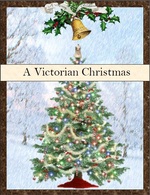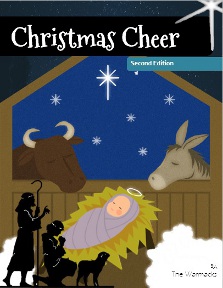The whole family can learn about Christmas symbols and participate in Advent activities in preparation for Christmas with the Christmas Cheer unit study. Or if you find the Victorian era fascinating, you might use the 25-day unit study, A Victorian Christmas, with activities and projects based on that theme. Both unit studies are available only as PDF downloads. Prices are for use for individual families. Check the publisher’s website for group class prices.
Christmas Cheer
This 44-page book has brief information about 13 symbols or customs that are associated with Christmas such as candy canes, Christmas caroling, and wreaths. The information is followed by web links and resource suggestions.
For example, for under Christmas wreaths, the first two links are to book that you can purchase. The first is a Dover sticker activity book and the other is likely to be available through your library. (Note that links are set to go to Amazon, but Adobe Reader does not allow links to Amazon to connect.) Next are weblinks to a number of wreath-making activities with instructions—a hand-print wreath, a tissue paper roll wreath, a popcorn wreath, a button wreath ornament, and a number of other options including some coloring pages for the younger children. Following the activity links are weblinks to creative recipes for two wreath-related foods to make and enjoy.
Some symbols include recommendations of family-friendly movies that fit the theme.
Next in the unit study book is a list of 24 “Random Acts of Christmas Cheer” that you might want to try. Suggestions include ideas like, “Placing a toy in the store collection bin,” “Bring cookies to neighbors,” “Leave change in a laundromat,” and “Pay for the person’s order behind you at a drive thru.” Gift cards are included that you might want to leave with “gifts” when appropriate.
The final section is titled “Advent Calendar.” It is referred to as an “advent countdown” elsewhere. These are not set up in a calendar format or any set order. Instead, they are a set of 24 small cards that you can cut out and use as you wish although some creative suggestions for their use are included. Each card has a family activity that relates to Christmas. “Read a Christmas story,” “Have a family slumber party by the Christmas tree,” and “Make gingerbread houses” are typical activities.
Descriptions of the symbols and customs often include mention of their Christian basis such as the explanation for Christmas wreaths on page nine: “Wreaths are in the shape of a circle. Circles symbolize no beginning or end, it is continuous. The love that Christ has for us is never ending!” However, other than “Set up a nativity set” in the Advent cards, there is nothing specifically Christian in the “Random Acts of Christmas Cheer” or the “Advent Calendar” activities. Consequently, it seems to me that Christmas Cheer should be great for any family celebrating Christmas that is interested in understanding the meaning behind some of its symbols whether or not they want to go further into the celebration of the birth of Jesus which lies at the heart of Christmas.
A Victorian Christmas
 A Victorian Christmas transports you back to the Victorian period for 25 days of preparation for Christmas but without any religious content. This study is more thorough and more detailed than Christmas Cheer. It includes weekly charts showing activities that will suit different learning styles and different interests, including more academically challenging research and writing assignments. At the back of the book are patterns for a few activities plus formatted pages to use for written reports. Of course, you are free to choose which of the activities you will use with each child.
A Victorian Christmas transports you back to the Victorian period for 25 days of preparation for Christmas but without any religious content. This study is more thorough and more detailed than Christmas Cheer. It includes weekly charts showing activities that will suit different learning styles and different interests, including more academically challenging research and writing assignments. At the back of the book are patterns for a few activities plus formatted pages to use for written reports. Of course, you are free to choose which of the activities you will use with each child.
As with Christmas Cheer, there are many weblinks included within the study that take you to websites for activities, recipes, and videos. Many links also take you to sites where you can read more about a topic. For example, the first day of the study begins with reading about and creating a silhouette. The online Encyclopedia Britannica article that explains silhouettes is written at a higher level, so you might have to read it yourself first then share appropriate information with younger children. Next, you can use the illustrated directions for creating your own silhouettes from A Victorian Christmas. Those who like to bake can follow the weblink to a recipe for Victorian Applesauce Cake. The chart often includes recommended movies or videos. For this first day, it recommends any version you like of David Copperfield. Under the heading “creative” on the chart, the study suggests: “Research more about the history of silhouettes and try your hand at more creative ones.” A link is included for creating “Sunset Silhouettes” using watercolors on a base paper then applying black silhouette shapes of buildings or landscapes.
You can see that trying to do all of the activities might consume most of your day, so choose those that best fit your situation rather than attempting them all. If possible, you might have children tackling different activities at the same time.
Some of the craft activities are really interesting and creative—I’d love to try the Victorian hat project and the decorated Victorian letters! Many of the activities are challenging—probably good for children at least ages eight or nine or older.
Recipes range from simple (Kids Friendly Christmas Wassail) to challenging (Turkish Delight candy). Most of the projects under the “Creative” heading require at least some research, but they often have follow-up activities. For example, “Research the history of your favorite candy and make a display on it” (from Day 2) or “Research the history of Tea Time and have a tea party!” (from Day 9).
Each week’s lesson material concludes with a few recommended books. Some of these are activity books, but some are non-fiction books about the Victorian era and some are novels such as The Christmas Doll by Elvira Woodruff or works by Jane Austen or Charles Dickens.
A Victorian Christmas offers a more-challenging option that might be better for older children than Christmas Cheer if you’ve got the time to actually do enough of the activities.









